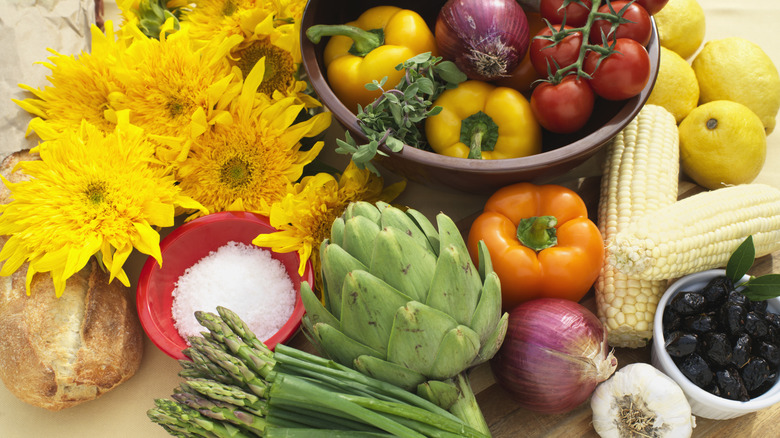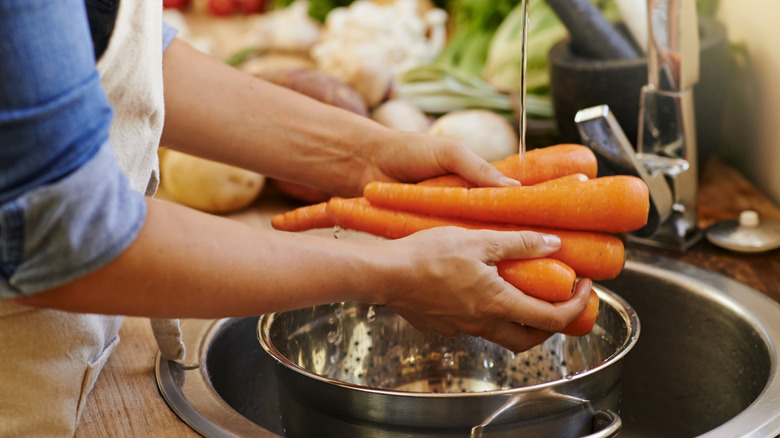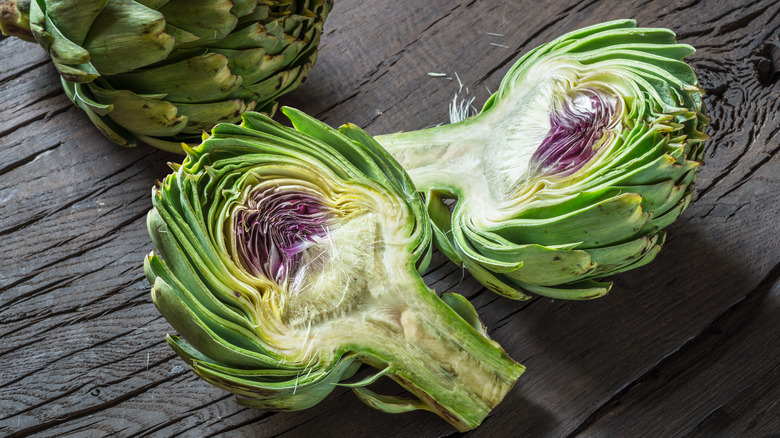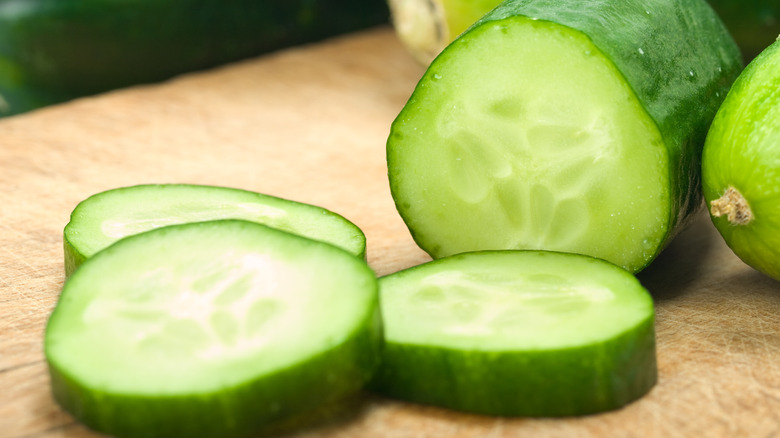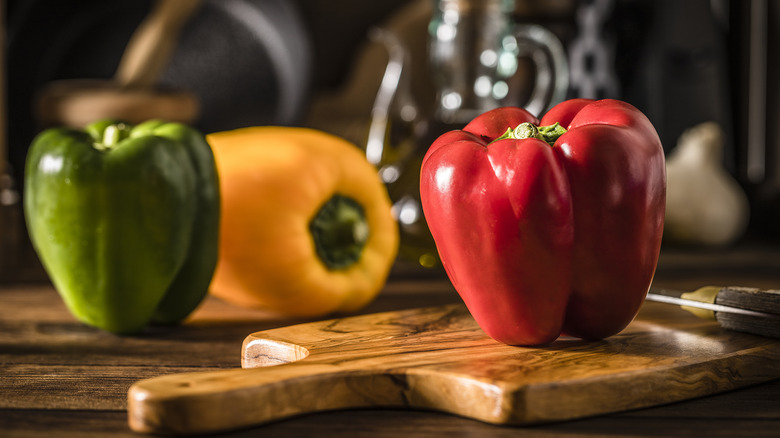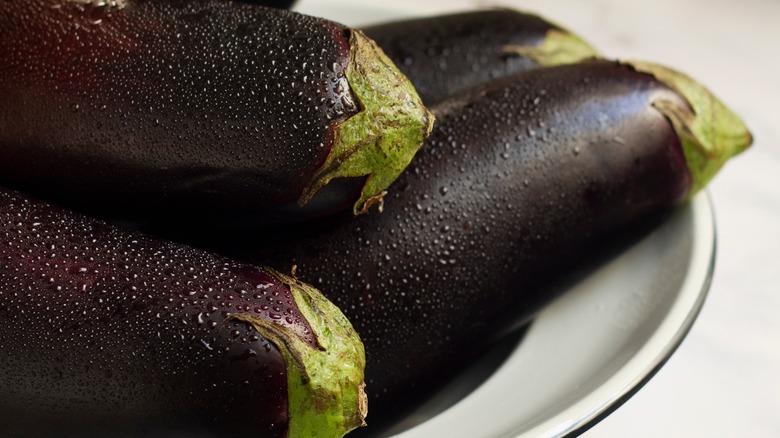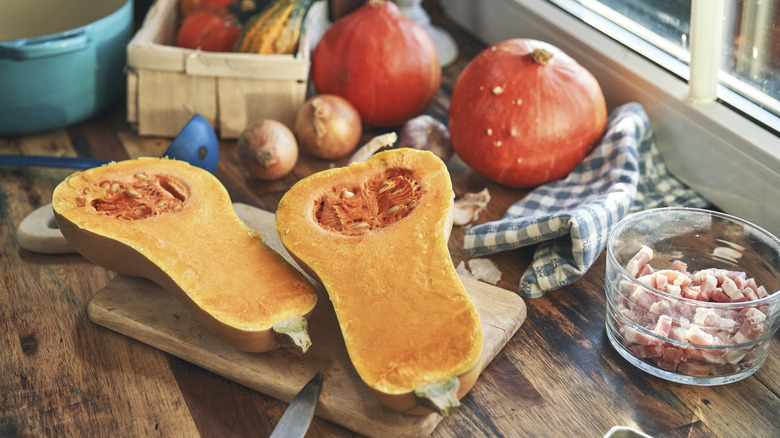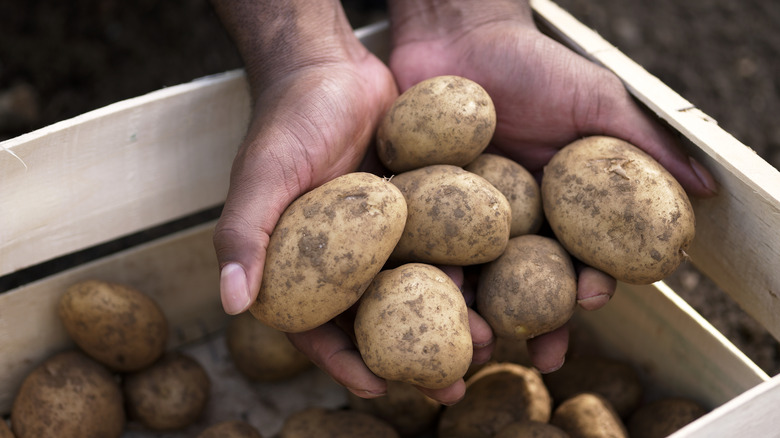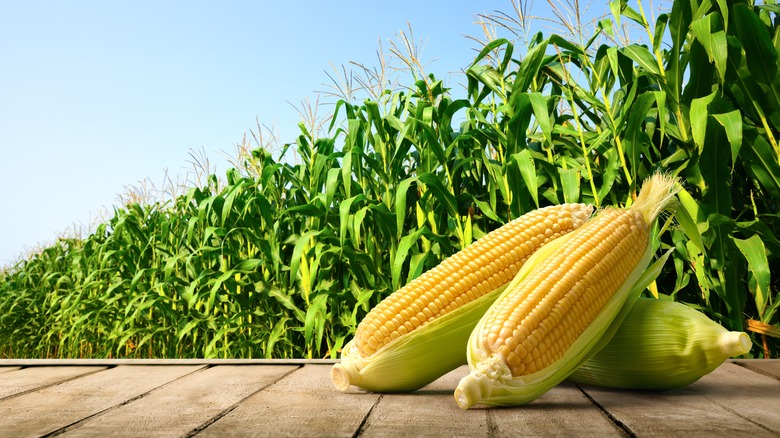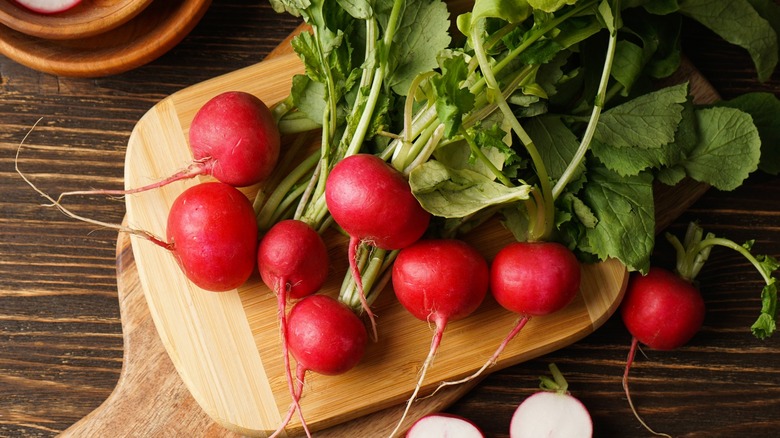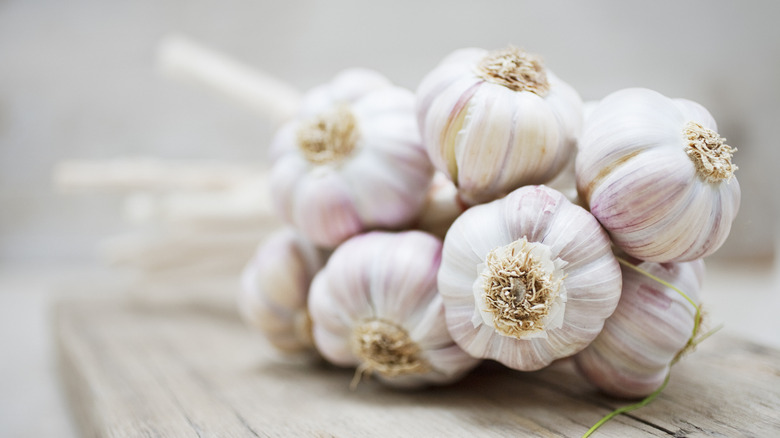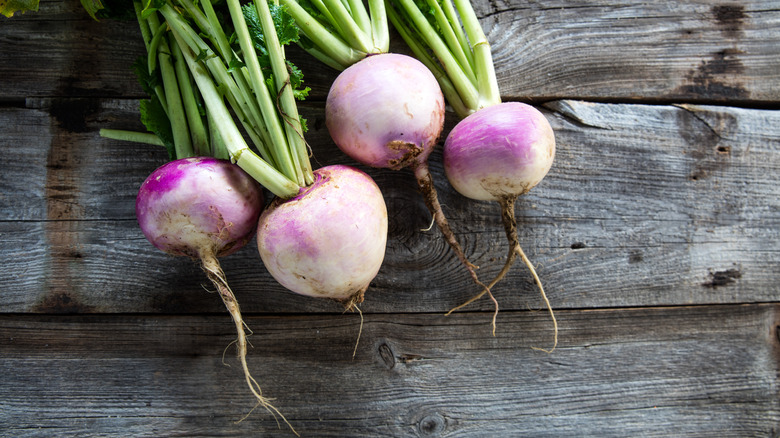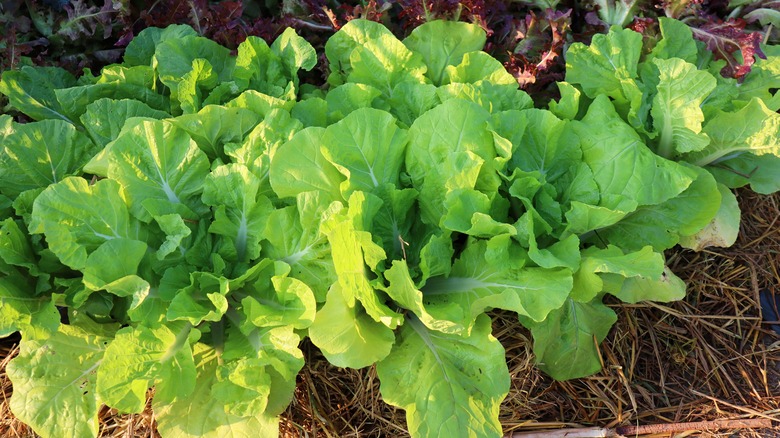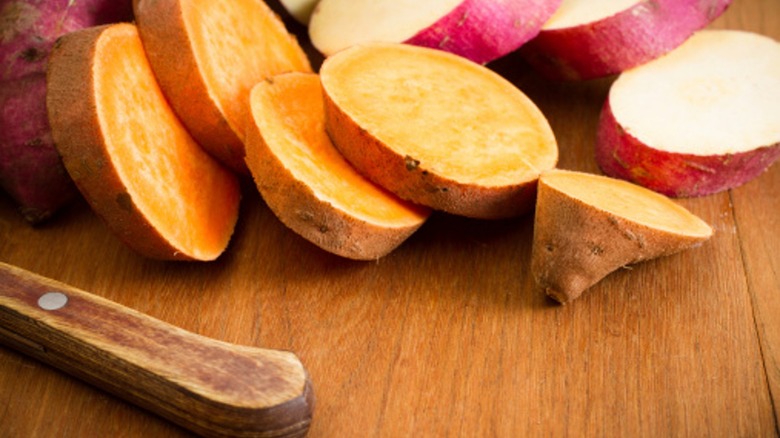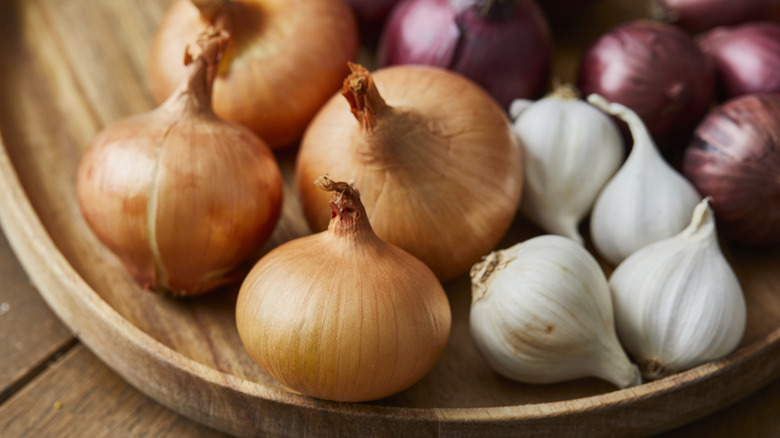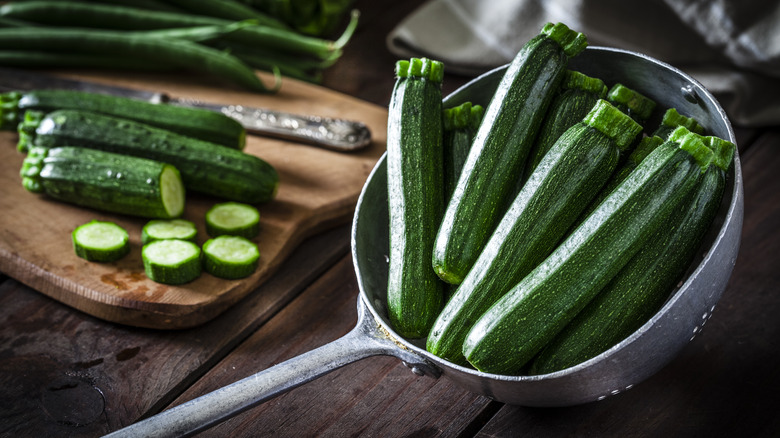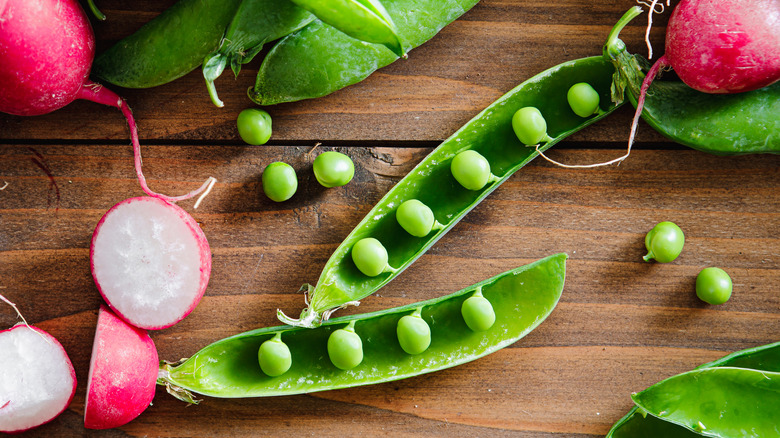8 Vegetables You Don't Need To Peel And 8 You Should
You may have heard that tomatoes are fruits, not vegetables. While that's true, it's because the term "vegetable" is a culinary one, not a botanical one. All vegetables are some part of the plant, whether it's the fruit, leaves, roots, or stem. The term vegetable generally refers to an edible part of the plant that's more savory than sweet.
There are numerous types of vegetables, which is good because vegetables are possibly the healthiest food group. They're often high in fiber and contain vitamins and minerals that your body needs. You just have to know how to properly prepare them.
Some vegetables need to be peeled before you prepare them, while others don't. In fact, in many vegetables, the majority of the nutrients are in the skin, and by peeling them, you lose those nutrients. Curious to know what vegetables you don't need to peel and which ones you should? We break it all down below.
Don't peel carrots
Carrots are one of the most popular vegetables in the United States, and for good reason: They're easy to eat as a snack, but can also be cooked in a variety of recipes. Carrots are root vegetables that grow underground, and while most carrots you see in the store are orange, they also come in shades of yellow, white, and purple.
Many people instinctively peel carrots, but that's not always necessary. You may want to peel older carrots, and peeled carrots are best for roasting, but often you can get by without peeling. This is not only easier but healthier, as most nutrients are in the carrot skin. Most of the time you just need to give them a good wash. The best way to clean carrots is to slice off the tops, put them under warm water, and use a brush to scrub off dirt and bacteria.
Carrots can make a great addition to a recipe and thrive as the center of attention, like in a creamy carrot casserole recipe or in countless other sweet and savory carrot recipes.
Peel artichokes
Artichokes are an unusual vegetable. They're actually the bud of the plant, and if not picked, will flower. The key thing you need to know about artichokes is that they're armored on the outside by thick leaves, often with thorns, which protect the delicious heart and inedible fluffy choke inside. Both the leaves and heart can be eaten, and are incredibly nutritious, high in fiber, folate, and magnesium, as well as other vitamins and minerals.
If you're planning to just eat the heart, your artichoke will need to be completely peeled, but even if you want the leaves you'll likely need to peel a little bit because the outer, base leaves are often tough or brown. Improper preparation is a common mistake with artichokes, and you'll need to wash them thoroughly, trim off the stem and tip, and remove thorns before you can eat them. Now that you know how to prep them, you can check out a variety of craveable artichoke recipes.
Don't peel cucumbers
Cucumbers are a refreshing vegetable that makes a perfect addition to a veggie tray. They come in many varieties but are typically green and cylindrical. Like bell peppers, they're the fruit of the plant, which comes as no surprise since they're related to watermelon. While nutrients vary between varieties, most cucumbers are high in vitamins, minerals, and dietary fiber.
These nutrients are exactly why you should leave the skin on your cucumbers. The skin holds the majority of the vegetable's nutrients, including vitamins A, C, and K, essential minerals like calcium, iron, magnesium, and zinc, and the majority of the vegetable's dietary fiber. However, like most vegetables, cucumbers need to be washed before serving.
One of the best tips for prepping cucumbers is to add a pinch of salt, especially if the cucumbers are for snacking or turning into a dressing. Otherwise, check out some refreshing cucumber recipes to use your cucumbers in new and delicious ways.
Peel bell peppers
Bell peppers are juicy, delicious vegetables that are botanically a fruit, as they hold the plant's seeds. The flavor depends on how ripe they are; green peppers are unripened, and have a more bitter flavor, while fully-ripe red peppers are sweeter. Yellow peppers fall somewhere in the middle. The riper they are, the more nutrients, like vitamin C and beta-carotene, they hold.
You don't always need to peel bell peppers, like if you're stuffing or roasting them. For other uses, peeling bell peppers is the way to go, as it makes the pepper incredibly tender and allows it to release its sweetness into the dish. A regular vegetable peeler works just fine for bell peppers, and you can skip any hard-to-reach indentations on the pepper.
Bell peppers are incredibly versatile and add just enough sweetness and crunch to elevate your meals. They're a highlight in simple one-pan chicken fajitas as well as these other bell pepper recipes we can't get enough of.
Don't peel eggplant
Eggplant, also known as aubergine, has several varieties, but most are oval-shaped and some shade of purple, with the shiny, dark purple ones being the most common in grocery stores. Eggplants are the fruit of the plant and are full of tiny seeds throughout the mild flesh. It's low in calories and carbs, but high in antioxidants and phytonutrients.
So, is it necessary to peel an eggplant? Definitely not. The skin of eggplant is edible and holds many of the vegetable's vitamins and nutrients. Peeling is one of the common mistakes everyone makes when cooking eggplant, but there's no reason to remove the skin. Some people aren't fond of the taste or texture, but that's more common with overripe eggplants.
The mild taste of eggplant makes it easy to use in several ways. You can fry or roast it on its own, use it for shrimp and eggplant stir-fry, or incorporate it into other easy eggplant recipes.
Peel butternut squash
Butternut squash comes from the same family as cucumbers, but it's a winter vegetable rather than a summer one. It's typically pear-shaped, weighs two or three pounds, and is loved for its sweet flavor and small amount of seeds. These squash are incredibly versatile and full of nutrients including vitamin A, vitamin C, magnesium, and potassium.
Like pumpkins and other winter squash, you'll typically want to peel the skin, as the texture can be tough and the taste can be unpleasant. The skin will soften as they cook, but if you're planning to slice or puree your butternut squash, you'll have to peel it first anyway. You'll need a sturdy peeler, as the skin is thick, and you'll want to keep peeling until you've reached the squash's signature vibrant orange flesh.Several cozy comfort recipes feature butternut squash as the main ingredient, including simple roasted butternut squash soup and savory mashed butternut squash.
Don't peel potatoes
Potatoes have been a pantry staple for centuries. There are many different kinds of potatoes, but all are somewhat round and grow underground. Potatoes are high in carbohydrates but also in vitamin C, folate, niacin, and magnesium, and as a result, have been a core part of many peoples' diets over the years.
The skin of a potato is edible and high in fiber and certain nutrients. As a result, you don't need to peel potatoes, and in fact, many ways of eating potatoes, like baked potatoes and loaded potato skins, require the potatoes to not be peeled. Other ways of serving potatoes, like mashed potatoes or fried potatoes, can work with or without the skin. However, if your potato has started to sprout, you're going to want to cut or peel those sprouts off, and you should always wash your potatoes.
Potatoes can be used in a variety of ways, either on their own or as part of a dish. They can't be eaten raw, but there are many ways to cook them, including boiling, baking, and frying. Check out some potato recipes for a few tasty ideas.
Peel corn
Corn is a somewhat unique vegetable, as it comes wrapped in a husk and is one of the few vegetables that shouldn't be eaten raw. Most corn we eat today has yellow or white kernels and a sweet taste, though the sweetness varies between varieties. That sweetness is due to the high amount of carbohydrates in corn, and the vegetable is also high in vitamins B6 and C as well as nutrients like magnesium, potassium, and zinc.
While some methods of cooking corn involve cooking it in the husk, all corn needs to be husked at some point before eating. Husking involves peeling away the leaves and the silk, which is much easier with a trusty potato brush. While the husks aren't edible, they can still be useful in the kitchen for wrapping foods, like authentic Mexican tamales. Corn is a staple when served as kernels or on the cob, but it's also great in recipes like warm elote corn dip Recipe and myriad other recipes for corn lovers.
Don't peel radishes
Radishes are swollen stems that grow underground. Most varieties in your typical grocery store are a shade of red or pink, but these veggies also come in shades of white and purple. There are many varieties of radish, and each has a slightly different look and flavor. They're a good source of vitamin C, and red radishes are high in phytonutrients.
Radishes almost never need to be peeled. Horseradish, which isn't technically a radish, does need to be peeled, but other types of radishes can keep their skin. The skin is completely edible, and all you need to do to prepare radishes is wash them and cut off their tops and root ends.
Many people eat radishes raw, like in salads, but they can be cooked and used in several ways. These radish hacks offer several innovative ways to use the vegetable, and if you're still unsure what exactly to do with it, you might just need a few tips for cooking with radishes.
Peel garlic
Few vegetables have a storied history like that of garlic; records first show it being used in 4,500 B.C. Garlic grows in a bulb underground and typically has white skin, but some varieties also have pink or purple skin. Most often, garlic is used as a spice or herb in dishes and is an ingredient in many types of recipes from many different types of cuisines.
Garlic cloves are held together by a thin, papery skin, and this needs to be removed before cooking. Peeling garlic can be a pain, but there are several methods to make it easier, like the convenient microwave hack or the ways they peel garlic at restaurants.
Though you don't eat garlic on its own, it can be used in a nearly endless amount of dishes. A few tips for cooking with garlic: use whole garlic cloves for a more mild garlic flavor, and mince for a stronger garlic taste. Garlic also tastes terrible when burned, and it burns quickly, so try to avoid putting it into your pan until the last possible moment.
Don't peel turnips
Turnips are a root vegetable that has been eaten since ancient Rome. Most turnips are a combination of purple and white and round, but the exact size and shape vary between varieties. Like many vegetables on this list, turnips can be eaten raw or cooked in several ways. Turnips are very nutritious, with high amounts of vitamin C and other important nutrients like fiber, folate, and calcium.
According to The New York Times, not all turnips need to be peeled. For turnips with a thin skin, all you need to do is wash them like you would other vegetables. Although the skin is edible, those with leathery and thick skin should probably be peeled just for taste and texture. You can trim off the tops of radishes to get a better look at how thick the skin is.
When cooking with turnips, you can often cook them in ways similar to potatoes, which means that some simple herbs and roasting will do the trick. You can also eat the leaves by making an easy turnip greens soup.
Peel lettuce
Lettuce is another popular vegetable that's commonly used for salads. They're typically some shade of green and have many layers of crisp, crunchy leaves wrapped around a central core. There are several varieties of lettuce, some more tightly packed than others. While nutrition depends on the type of lettuce, lettuce is generally a source of vitamin C and folate and is about 95% water.
Often, the outer, bottom layers of leaves end up damaged and wilted. These can also be the dirtiest and should be peeled away before you wash your lettuce. Due to the many layers of leaves, lettuce can become a haven for E.coli and other dangerous bacteria, and should always be soaked and washed before the lettuce is prepared.
Lettuce can be turned into a salad, added on a sandwich or burger, and much more. The best way to keep lettuce fresh is to keep the leaves in an airtight container in the refrigerator.
Don't peel yams
Yams are tubers that grow underground and typically taste similar to Russet potatoes. There are several different types of yams, and they vary in size, color, and sweetness. While yams aren't the most common of vegetables, most people should be eating more yams because they're incredibly nutritious. These tubers are a great source of folate and also contain vitamin A, vitamin B6, and potassium.
Yams don't need to be peeled unless a recipe specifically calls for peeling. A lot of the nutrients are in the skin, and when you peel them, you lose those nutrients. Instead, all you need to do is scrub them clean and remove any blemishes, similar to how you would prep potatoes.
Yams, like potatoes, can be cooked in many ways, such as baked, boiled, steamed, or roasted. The term "yam" is often used interchangeably with "sweet potato," but these two vegetables are not the same and you can't just substitute yams with sweet potatoes.
Peel onions
Onions, like garlic, grow underground and are covered in a thin papery skin. These staple vegetables are both eaten raw and cooked in a variety of recipes. Onions come in several different varieties, and while all are round, they vary in size, color, and flavor. While they aren't rich in some of the most common nutrients, they do have a high amount of phytonutrients.
No matter how you plan to eat it, before you prepare your onion, you need to get rid of that papery skin on the outside. The peel isn't edible, but that doesn't mean you need to throw away onion peels. They work great for seasoning soups and stocks and can be easily removed before the dish is served.
One of the common mistakes everyone makes when cooking onions is not cutting them properly.You also want to be sure to choose the right type of onion for your dish and be sure your onion hasn't gone bad.
Don't peel zucchini
If you're not familiar with this vegetable, you might be wondering, what is zucchini? Zucchinis are a type of summer squash that is usually dark green but may also be yellow depending on the variety. These squash are harvested before they're fully mature and they usually have a slightly sweet taste. They're high in fiber and contain vitamins A and C.
Zucchini shouldn't be peeled, especially since most of the nutrients are in the skin. Just scrub it up before you prepare it, and it will be ready to eat raw or be baked, grilled, or sauteed. Watch out for common mistakes you need to avoid with zucchini, like choosing the wrong type or overcooking it.
Zucchini can be eaten on its own, and it's also a great substitute for noodles, as seen in this vegetarian spaghetti "carbonara" recipe. Additionally, zucchini works fabulously in a variety of dishes, including desserts.
Peel peas
Peas are another ancient vegetable. There are several varieties, but all come inside a pod. These little round green seeds can be eaten fresh but are often incorporated into dishes or served as a side. They're full of nutrients, including vitamins A, B6, and C, as well as folate, iron, magnesium, and potassium.
Fresh, standard peas need to be removed from their shells. A tip for cooking with peas is to first roll the shells between your fingers to loosen the peas inside the pod, then gently work the peas out with your fingers. You can also cut the shells and peel them apart. However, snow peas are meant to be eaten in the pod, and snap peas can be eaten either way.
Peas work well on their own, for example, in this flash-fried snow peas recipe. They're also fantastic in casseroles, stir-fries, or as the star of this chunky slow cooker split pea soup.
